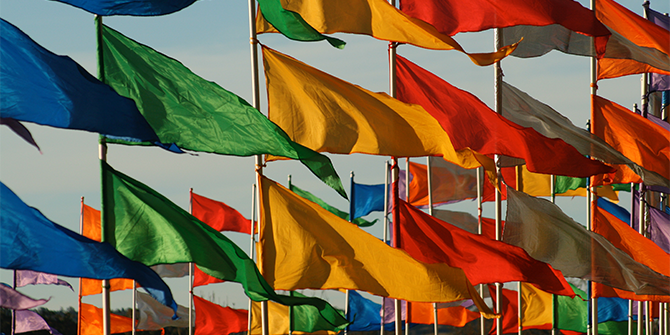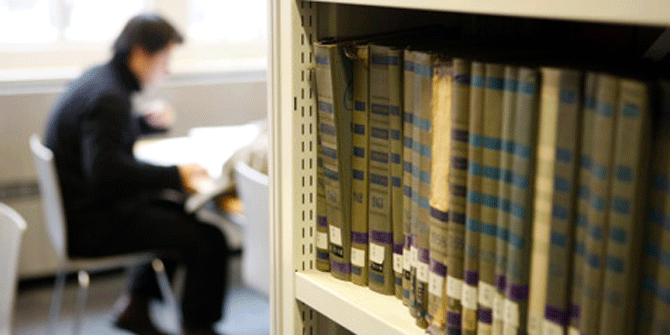Miguel Lara Otaola explores nationalism and its consequences for peace by asking how flags help promote solidarity and give people a sense of belonging, while at the same time have the potential to become a symbol of exclusion and occupation.
“These are the stakes. To make a world in which all of God’s children can live, or to go into the dark. We must either love each other, or we must die.” Lyndon B. Johnson, 1964.
On September 11, 2001, three New York City firefighters spontaneously decided to hoist the American flag over the still-smouldering rubble of the World Trade Center. “The country got attacked, there’s all this devastation, thousands of people died; let’s do something good right now” was the motivation of the brave firemen still covered in dust who had just lost many of their colleagues and friends. Behind the camera, photographer Thomas Franklin similarly felt compelled to take the picture as the action told him ‘something about the strength of the American people.’ That image encouraged many to participate in the rescue, remove debris, and help in any possible way. That same flag is now displayed at the entrance of the National September 11 Memorial and Museum.
A little over one year later the use of the ‘Stars and Stripes’ led to quite a different reaction. In April 2003 during the invasion of Iraq and in the aftermath of the September 11 attacks, American troops stormed into Baghdad to find a group of Iraqi civilians attacking a statue of Saddam Hussein in Firdos Square. Before helping to topple the statue with an armoured vehicle – symbolising the end of Hussein’s regime – an American marine placed a US flag over the statue’s head. Cheering civilians went silent and outrage followed. “That should have been the Iraqi flag” an Al Arabiya announcer insisted. In this case the American flag was not seen as a symbol of liberation or strength, but rather one of occupation. The flag was removed and replaced by an Iraqi flag almost immediately.
How can the same flag lead to two disparate reactions? It all depends on how, when, and where we brandish our flags. Flags and the idea of nationality behind them are powerful. Nationalism can promote loyalty, pride, and unity. It can inspire us to do our best and foster solidarity and cooperation. Nationalism creates ties with strangers and gives people a sense of belonging. We might not know each other, but we are part of a larger community and serve a common purpose; we pay taxes and care for our fellow citizens. Nationalism, nonetheless, can also propagate division. While some individuals and groups are considered to be part of a collective, others are not. Including some necessarily entails excluding others. Solidarity only goes as far as the physical and cultural borders of the state – the in group. What about those that do not belong to the nation? Are other nations or peoples as worthy as our own?
More importantly, if not properly contained or moderated, nationalism can ultimately pave the way to war. Classic examples are the devastating conflicts that emerged in the Balkans after the breakup of Yugoslavia in 1991. Here, a number of different ethnic groups fought each other to guarantee not only self-determination but, in some cases, ethnically homogeneous units, even leading to ethnic cleansing and genocide. Slobodan Milosevic’s atrocities in the Bosnian war are a case in point. Hence when we think about the relationship between nationalism and war what usually comes to mind is a situation similar to this. Nationalism, however, can also lead to conflict in more subtle ways.
The First World War is a perfect example. The “Belle époque” leading to World War I, was not only a time of wealth, prosperity, and cultural expansion. Behind the opulent veneer of ballrooms, conflict was lurking. The late nineteenth and early twentieth centuries experienced unprecedented growth in trade, production, and communications. Never before had so many goods, ideas, and people, moved about the globe. This thriving world, though, was riddled with contradictions. This was also an ‘Age of Empire,’ where national economies competed for resources, markets, and overseas colonies. Tensions between the great powers grew, leading to increases in military spending, a surge in local conflicts and eventually to war.
This was largely fuelled by the growth of nationalism. This is the time of Italy’s ‘Risorgimento’ under Cavour and Germany’s unification by Otto von Bismarck. This encouraged states to put themselves first and above all others. Not only were states looking for their ‘place in the sun,’ but also businesses increasingly demanded protections from foreigners. Protectionism and tariffs grew alongside rivalries and national pride –a dangerous combination. Moreover, with the increasing waves of mass-migration that characterised this era, patriotism turned to chauvinism. As a result, a seemingly peaceful and prosperous world slowly but surely drifted into division and ultimately to war.
As the maxim goes, history does not repeat itself, but it often rhymes. From their touchiness to their unpredictability and narcissism, a few observers have already pointed out the curious similarities between Kaiser Wilhelm and Donald Trump. Beyond this caricature true echoes of this time can be found in the world today. First, national rivalries are centre stage once more and some key countries are increasing their military stockpiles (namely Russia, Turkey, and China). Moreover, China is on a path to overtake the US, the same way Germany may have overtaken Britain, creating tensions between both nations. This has resulted in a trade war with tariffs on over $300 billion of Chinese and American goods, and to tensions in the South China Sea where Chinese claims and the proximity of Chinese and American warships have the potential to escalate into a larger conflict. After all, the assassination of Archduke Franz Ferdinand in Sarajevo in June 1914 was just the spark that set off the powder keg.
Second, flags are again being waved all around the world. In Europe the nation state is becoming more important to voters and a number of nationalist-populist parties have gained unprecedented support, have entered governments, and gained seats in parliaments. In Italy, Lega Norde’s Deputy Prime Minister Matteo Salvini has criticised Brussels and the EU and promises to put ‘Italians first.’ In the UK the outcome of the Brexit referendum can partly be explained by concerns over immigration and the desire to ‘take back control’ of national sovereignty. In Hungary, Prime Minister Viktor Orbán calls for ‘Hungary first’ and extols nationalism and ‘the homeland’ over democracy and human rights. In the United States Donald Trump claims his only policy is ‘America first’. The list goes on – Duterte in the Philippines, Erdogan in Turkey, and Putin in Russia are just a few more examples.
Not everyone can come first, and when this happens conflict is likely to follow. How, then, can we avoid replicating the fate of 1914? Nationalism can be a positive force and lead to cooperation, solidarity, and nail-biting football matches. To achieve this we should redefine nationalism, remove its antagonistic and belligerent side, and strip chauvinism and nativism from it. This has already been done in art by Luke Jerram’s Flag Machine which alters the meaning of flags, the idea is simple: flags enter one side bearing colours and emblems and come out the other side painted white. White flags are a sign of truce and negotiation which are universally recognised symbols of peace and surrender.
How can we accomplish this outside an art gallery? Firstly, nations should strengthen integration and international cooperation between themselves. It is through cooperation and partnerships between nation states that common issues – from security to climate change – can be tackled. It is largely thanks to multilateral cooperation via the EU and NATO that war in Europe has become ‘not merely unthinkable, but materially impossible.’ As a result, Europe has known its longest period of peace between its major powers in over 2,000 years. Secondly, as citizens we should condemn the negative aspects of nationalism, we should stand up against racism, exclusion, and we should vote against the politicians that seek to divide us in this fashion. The ‘other’ –whether an individual, a group of individuals, or a nation– is not the enemy. If we allow divisions to grow and we put ourselves too far above others we may as well prepare for a reloaded 1914. Lest we forget.
 Miguel Lara Otaola is Head of Mission for Mexico and Central America for the International Institute for Democracy and Electoral Assistance (International IDEA). He has worked for the United Nations Development Programme (UNDP), the Overseas Development Institute in the UK, the Electoral Integrity Project at the Universities of Sydney and Harvard and Mexico’s National Electoral Institute (INE). He holds a PhD in Politics from the University of Sussex and an MSc in Comparative Politics from the London School of Economics (LSE). Twitter: @malaraotaola.
Miguel Lara Otaola is Head of Mission for Mexico and Central America for the International Institute for Democracy and Electoral Assistance (International IDEA). He has worked for the United Nations Development Programme (UNDP), the Overseas Development Institute in the UK, the Electoral Integrity Project at the Universities of Sydney and Harvard and Mexico’s National Electoral Institute (INE). He holds a PhD in Politics from the University of Sussex and an MSc in Comparative Politics from the London School of Economics (LSE). Twitter: @malaraotaola.
Note: this article gives the views of the author, and not the position of the LSE Department of Government, nor of the London School of Economics.






